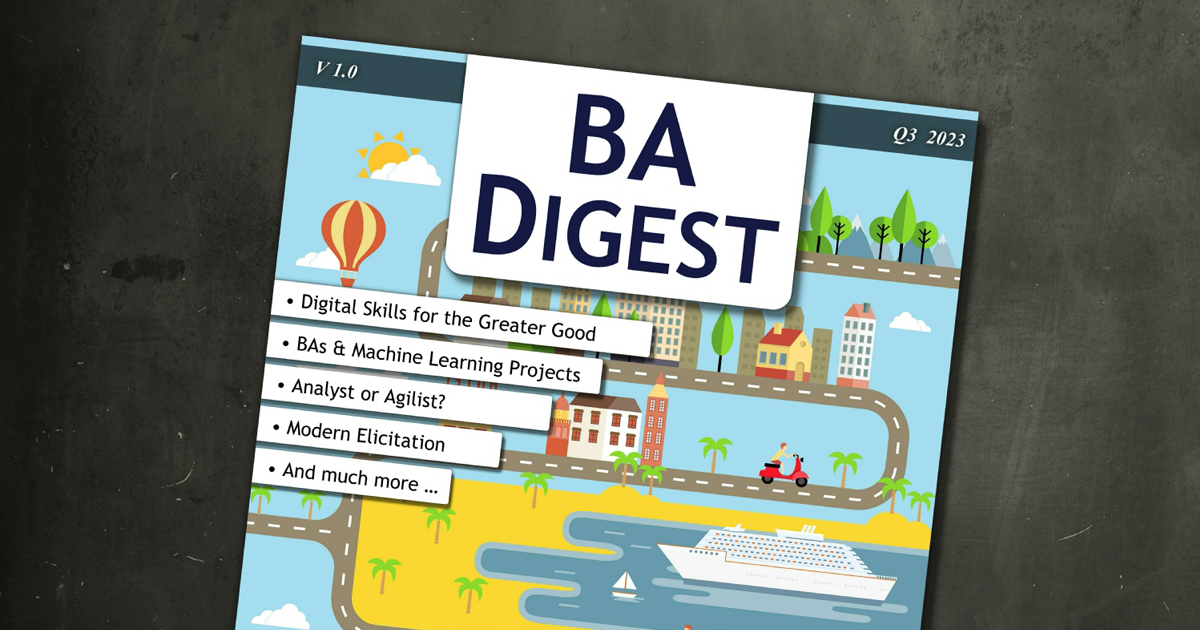Agility, Social Causes, and Machine Learning
3 Key Takeaways from BA Digest (Q3 Edition)
Receive free IIBA updates and exclusive content!

One of the aims underpinning BA Digest magazine is to assemble a diverse range of viewpoints from a variety of authors. There are fifteen fantastic articles in the current edition, which are well worth reading.
If you’re short of time, here’s an espresso-sized summary to whet your appetite…
1. Agile or Waterfall? It’s Not a Binary Choice
In “To Agile or Not to Agile: An Iterative Dilemma,” Anna Rajander discusses when to mix different delivery approaches. The binary view—where a project is either entirely waterfall or agile—is increasingly being challenged.Project approaches are now being viewed on a spectrum, with predictive/waterfall style approaches and adaptive/agile approaches at either end. There are many other positions in between. Combining them is not as simple as mixing different coloured paints. It’s more like mixing water and oil.
When a project has a clearly defined scope, well-defined deliverables, and known or easily discoverable solution requirements, waterfall may work. However, agile is more suitable when the product scope and the delivery approach has at least some flexibility. When the project must follow prescribed processes but some deliverables have ambiguous solution requirements, a combination of approaches might work best.
A key takeaway is that there really doesn’t need to be a “methodology war.” Agile and waterfall approaches have their place. The important thing is to select or combine them in a way that is appropriate for the context.
2. Business Analysis for Good
Have you ever wanted to donate your time to a community cause? In “Digital Skills for the Greater Good….BAs to the rescue?”, Sarah O’Neil shows how business analysis practitioners can give back.
Sarah describes liaising with Getaway Girls, a 35-year-old charity in Leeds, UK, that supports girls and young women. By helping it clarify its growth strategy, Sarah used her business analysis skills and got additional experience and exposure. And she did it using classic tools and frameworks such as POPIT, SWOT, and PESTLE.
Sarah’s underlying message is that business analysis practitioners have so much to give to social initiatives. Even donating a day or two of your time can make a huge difference.
3. What Business Analysts Need to Know About Machine Learning Projects
In this article, Anton Reshetnikov describes how business analysis practitioners working on machine learning (ML) projects require different skills.A type of artificial intelligence, ML enables computers to learn from data and make predictions or decisions without being explicitly programmed. ML algorithms can be used for various applications such as image recognition, language translation, fraud detection, and recommendation systems. Their success depends on factors like data quality, algorithm choice, and the model's ability to generalize to new data.
At the beginning of an ML project, it is crucial to clarify certain aspects to ensure objectives are met. The project objective must be clearly defined to avoid scope creep and meet stakeholders' expectations.
Data availability is also crucial. The analyst needs to understand the quality, completeness, and relevance of the data to the project's objective. If the data is incomplete or low quality, the analyst and technical team must collaborate to address missing values or outliers.
Data preparation, which involves cleaning and transforming data to make it suitable for ML algorithms, is another important step. Select an appropriate algorithm, evaluate the model with a test data set, and ensure the model can be effectively deployed.
Business analysis practitioners working on ML projects require specific skills and knowledge, alongside their general business analysis expertise.
Context is Crucial
A key thread throughout these articles is that the context in which different business analysts operate can be very different. As such, the tools, techniques, and approaches that need to be deployed will also vary.
There is a broad business analysis toolkit—just look at the BABOK Guide, IIBA’s Knowledge Hub, and the IIBA Members’ Digital Library! So we need to continue learning and flexing our business analysis muscles, within our organizations and sometimes even beyond them.
For more thought-provoking articles, be sure to download BA Digest.
Keep on learning. Until next time.
About BA Digest
BA Digest is a free, open access, quarterly magazine published by Blackmetric. It focuses on all things related to business analysis.
About the Author:

Adrian Reed is a true advocate of the analysis profession. He acts as Principal Consultant at Blackmetric Business Solutions, where he provides business analysis consultancy and training solutions to a range of clients in varying industries. He is editor-in-chief of the quarterly open-access magazine BA Digest, and he speaks internationally on topics relating to business analysis and business change. Adrian wrote the 2016 book Be a Great Problem Solver… Now and the 2018 book Business Analyst.



